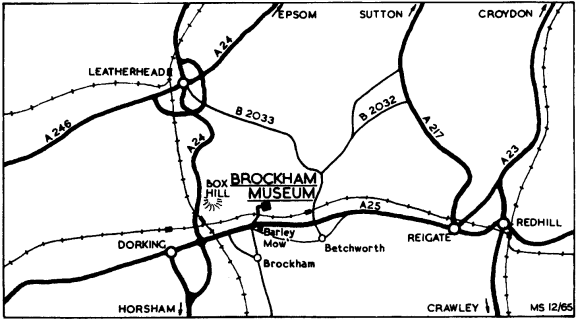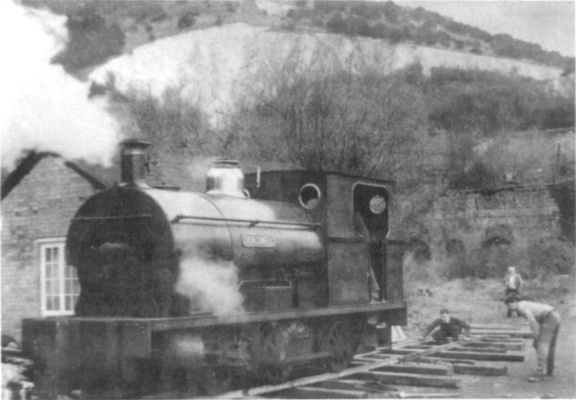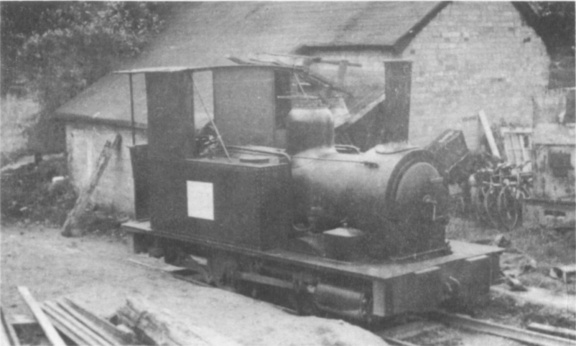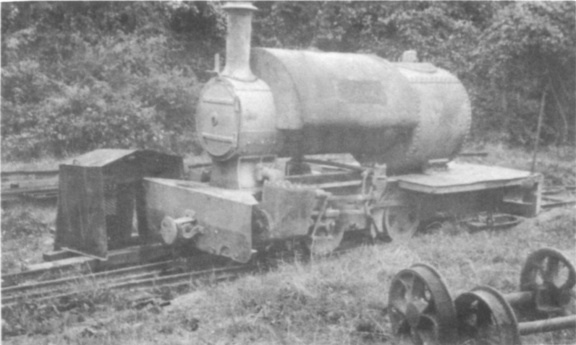
| THE INDUSTRIAL RAILWAY RECORD |
© MARCH 1966 |
LOCOMOTIVE PRESERVATION
(2) BROCKHAM NARROW GAUGE MUSEUM
ANDREW NEALE
(Photographs by the Author)
In October 1961 representatives of the Narrow Gauge Railway Society visited the disused quarries of the Brockham Lime & Hearthstone Co. Ltd. in Surrey, to determine whether the site would be suitable as a permanent home for TOWNSEND HOOK. This 3ft 2¼in gauge Fletcher Jennings 0−4−0 side tank locomotive (works number 172L of 1880), acquired by the Society from the Dorking Greystone Lime Co. Ltd.‚ Betchworth, Surrey, in 1960 was then on display at Sheffield Park Station on the Bluebell Railway. The site was readily suitable, for it was within easy reach of London and buildings were available. In addition the trackbed of the former standard gauge connection to the British Railways Redhill-Guildford line half a mile away could be used for any new projected narrow gauge line.
Site clearance began during the first few months of 1962 and on several occasions working parties visited the pits at Betchworth to salvage equipment from the defunct 3ft 2¼in gauge system; this included rail, sleepers, one end-tipping wagon and one side-tipping wagon. Major E. W. Taylerson, Managing Director of the Company, also generously placed on permanent loan to the Museum the two Orenstein & Koppel diesel locomotives from Betchworth (7269 3ft 2¼in gauge, and 7741 - 2ft gauge). The first exhibit actually to arrive at Brockham was TOWNSEND HOOK which was transported from Sheffield Park in May 1962, and this was followed a week later by the diesels and wagons from Betchworth. Incidentally Orenstein & Koppel 7269 was only just saved from cutting up and part of the engine bonnet had later to be welded back on!
On 19th May 1962 the work of building up the Museum was inaugurated officially by Major Taylerson and Orenstein & Koppel 7269 was named THE MAJOR in recognition of his help and generosity. During the next eighteen months a water supply was laid to a cottage used by the Museum, and the adjoining stables were rebuilt with a new roof supported on a steel framework to serve as a shed for TOWNSEND HOOK. This building will eventually become a workshop where all exhibits will be restored and maintained.
On learning of the impending closure of the Staveley Minerals ironstone quarry at Scaldwell in Northamptonshire it was decided that one of the Peckett 3ft gauge locomotives should be preserved. After much negotiation SCALDWELL (Peckett 1316 of 1913) was purchased and in March 1964 it travelled to Brockham to join a side-tipping ironstone wagon and a three-way point (donated by Staveley Minerals Ltd.) which had arrived two months earlier. SCALDWELL was the first locomotive to be steamed at Brockham because of the impossibility of offloading it directly into the shed as planned. Steam was raised at low pressure and SCALDWELL moved slowly across an area of soft ground on temporary track into its shed.



TOWNSEND HOOK outside the museum in August 1962.

PETER, the Bagnall from Cliffe Hill, in September 1965.
The aim of the Society at Brockham is to present a working Museum where various exhibits can eventually be demonstrated. It is therefore the intention to lay a 2ft gauge track which will be operated initially by Orenstein & Koppel 7741, and later by a steam locomotive. The opportunity to do this arose when the Cliffe Hill Granite Co. Ltd. (Leicestershire) generously donated the Bagnall 0−4−0 saddle tank PETER (2067 of 1917), then in store at Markfield, providing that it was put into full working order. PETER arrived at Brockham on 21st August 1965, and although it will require retubing, the replacement of some small fittings and the building of a new saddle tank and bunkers, it is generally in a very sound condition.
Two further exhibits to arrive during August 1965 were the Hudson bogie coach from the 2ft gauge line at Fauld Royal Air Force Unit in Staffordshire (donated by M. E. Engineering Ltd., of Cricklewood) and the 3ft gauge Bagnall coach built in 1895 from the Rye & Camber Tramway. Unfortunately only the underframe of the latter arrived as the body had reached such an advanced state of deterioration that it would not have survived the journey from East Guldeford, near Rye, on the back of a lorry. However, several large sections of the body, including the roof, have been saved and prior to dismantling full working drawings were prepared and numerous photographs taken so that the coach may be rebuilt and completely restored at a later date.
In December 1965 the opportunity arose to acquire what must be the most fascinating and unusual exhibit of all. Arthur Guinness Son & Co. (Dublin) Ltd. agreed to present the Museum with an unusual 1ft 10in gauge locomotive (No.23) from their St. James Gate Brewery railway in Dublin, together with a "converter" truck (No.3) which enabled a 1ft 10in gauge locomotive to work over 5ft 3in gauge track. Both these vehicles were built by William Spence Ltd., of Dublin, the former in 1921, and are in very good working condition. The Museum intends to demonstrate these units regularly in steam, and a suitable changeover gantry is being acquired for this purpose and for general use. Only in working condition will enthusiasts and the public alike be able to appreciate the unique features.
At the time of writing the work in hand comprises the putting into working order of Orenstein & Koppel 7741 (now named MONTY), the engine and gearbox having already been completely stripped and renovated; and also the repair and repainting of the Fauld coach, the conversion of a store into an additional locomotive shed and the preparation of a temporary track for the testing and demonstrating of 2ft gauge equipment, A certain amount of work is also being carried out on the rebuilding of PETER.
In the near future it is hoped to form a private limited company to administer the Museum. Financially, the transport of the Guinness items is of the greatest priority and approximately £200 must be raised. If you would like to support this venture or help with the other work of the Museum, please send a donation to the BROCKHAM MUSEUM FUND, 52 Bardon Road, Coalville, Leics. Mr J. L. Townsend, Museum Secretary (same address) will be pleased to supply further details of the Museum if required.
|
|
The construction of the Manchester Ship Canal, "whereby Manchester has become Britain‘s third seaport, involved over 53 million cubic yards of excavation and was the first occasion on which large-scale mechanised earth-moving was carried out in this country. 97 steam navvies, 173 steam locomotives, 6,300 railway trucks and over 200 miles of specially laid railway track were employed". (A.N.)